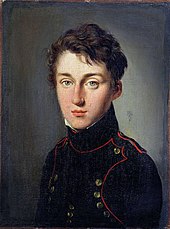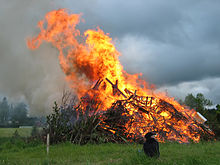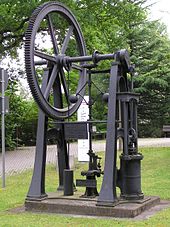Energy
![]()
This article is about the physical quantity. For other meanings, see Energy (disambiguation).
Energy is a fundamental physical quantity that plays a central role in all branches of physics as well as in technology, chemistry, biology and economics. Its SI unit is the joule. The practical significance of energy often lies in the fact that a physical system can give off heat, do work, or emit radiation to the extent that its energy decreases. In a system that is closed to its surroundings, the total energy does not change (law of conservation of energy). The importance of energy in theoretical physics lies, among other things, in the fact that the law of conservation of energy, originally a fact of experience, can already be inferred from the fact that the fundamental physical laws of nature are invariant in time.
Energy comes in different forms that can be converted into each other. Examples of forms of energy are potential, kinetic, electrical, chemical and heat energy (thermal energy). Examples of such transformations of energy are a person lifting a package or accelerating a bicycle, a battery being charged, a living being metabolizing, or a heater giving off heat.
The energy of a system depends on its state, i.e. on the parameters of the system and the instantaneous values of its variables. According to the Hamiltonian equations of motion, the Schrödinger equation or the Dirac equation, the form of this dependence determines in all details the temporal evolution of the system.
According to relativity, rest energy and mass are linked by the equivalence of mass and energy ( 
History of the term
The word energy goes back to ancient Greek ἐνέργεια, energeia, which in ancient Greece had a purely philosophical meaning in the sense of "living reality and efficacy" (see also "act and potency"). As a scientific term, the word itself was not introduced into mechanics until 1807 by the physicist Thomas Young. The new quantity energy was intended to indicate the strength of quite specific effects which a moving body can produce by its motion, and which cannot be determined solely by its momentum 

Lifting a weight of 








The correct prefactor 

In order to predict the above effects of the motion of the body, Young defined the quantity energy as the ability of the body to travel a certain distance against a resisting force. He also noted that work done on a body in the form of lifting work is later found quantitatively in its energy, but did not yet arrive at the notion of conversion of different forms of energy and also retained Leibniz's formula 
In the 18th century, mechanics and physics were not particularly interested in energy; important researchers such as Euler saw the dispute over the vis viva, the true measure of force, as a matter for the philosophers, and they were concerned with solving the equations of motion primarily in celestial mechanics. The concept of energy in the modern sense found its origin not with the analytical mechanics of the 18th century, but with the applied mathematicians of the French school, including Lazare Carnot, who wrote that living force can manifest itself either as 


In connection with the steam engine, the idea developed that heat energy is the cause of a moving energy, or mechanical work, in many processes. The starting point was that water is converted to a gaseous state by heat and the gas expansion is used to move a piston in a cylinder. The force motion of the piston reduces the stored heat energy of the water vapor. The relationship between mechanical energy and heat was demonstrated in famous experiments by Benjamin Thompson (Count Rumford, Munich 1796, 1798) and Humphry Davy (1799).
The physicist Nicolas Carnot realized that a change in the volume of steam is necessary when performing mechanical work. He also discovered that the cooling of the hot water in the steam engine does not only occur through heat conduction. Carnot published these findings in 1824 in a highly regarded paper on the operating principle of the steam engine. In 1834, Émile Clapeyron put Carnot's findings into mathematical form and developed the graphical representation of the Carnot cycle still used today.
In 1841, the German physician Julius Robert Mayer published his idea that energy can neither be created nor destroyed, but only transformed. He wrote to a friend, "My contention is ...: Falling force, motion, heat, light, electricity, and chemical difference of ponderabilia are one and the same object in different manifestations." The amount of heat lost in a steam engine would be exactly equal to the mechanical work done by the engine. This is known today as "conservation of energy," or the "first law of thermodynamics."
In 1854, the physicist Rudolf Clausius improved the ideas about energy conversion. He showed that only part of the heat energy can be converted into mechanical work. A body in which the temperature remains constant cannot perform any mechanical work. Clausius developed the second law of thermodynamics and introduced the concept of entropy. According to the second law, it is impossible for heat to independently transfer from a colder to a warmer body.
In 1847, Hermann von Helmholtz formulated the principle "on the conservation of force" and the impossibility of a perpetuum mobiles (perpetuus, lat. eternal; mobilis, lat.: movable) of the first kind. Many inventors at that time still wanted to produce machines that generated more energy than was put into them. Helmholtz found his insights by working with electrical energy from galvanic elements, especially a zinc/bromine cell. In later years he linked entropy and the heat generated by a chemical conversion to free energy. Both Mayer and Helmholtz had difficulty publishing their findings in the 1840s, however, because both were initially considered outsiders from outside the field and physicists in Germany were on the defensive against the natural philosophy of Schelling's circle, which had been influential since the end of the 18th century, and both were suspected of being followers of this speculative physics.
In 1878, Josiah Gibbs came to similar conclusions as Helmholtz with electrochemical cells. Chemical reactions only take place when the free energy decreases. The free energy can be used to predict whether a chemical transformation is possible at all or how the chemical equilibrium of a reaction behaves when the temperature changes.
After Wilhelm Wien (1900), Max Abraham (1902), and Hendrik Lorentz (1904) had already published considerations on electromagnetic mass, Albert Einstein published in 1905, within the framework of his special theory of relativity, the insight that mass and energy are equivalent.

Nicolas Léonard Sadi Carnot

Hermann von Helmholtz
Forms of energy and energy conversion
→ Main article: Energy converter
Energy can be contained in a system in different ways. These ways are called forms of energy. Examples of forms of energy are kinetic energy, chemical energy, electrical energy or potential energy. Different forms of energy can be converted into each other, but the sum of the amounts of energy over the different forms of energy before and after the energy conversion is always the same.
A transformation can only take place in such a way that all other conservation variables of the system also have the same value before and after the transformation. For example, the transformation of kinetic energy is limited by the conservation of momentum and angular momentum of the system. A spinning top can only be slowed down, and thus lose energy, if it simultaneously releases angular momentum. Such constraints also exist at the molecular level. Many chemical reactions that would be energetically possible do not occur spontaneously because they would violate conservation of momentum. Other conservation quantities are the number of baryons and the number of leptons. They constrain the conversion of energy by nuclear reactions. The energy contained in the mass of matter can only be completely converted into another form of energy with an equal amount of antimatter. Without antimatter, the conversion by means of nuclear fission or nuclear fusion succeeds only to a small extent.
Thermodynamics gives another condition for a transformation with the second law of thermodynamics: The entropy of a closed system cannot decrease. Withdrawal of heat without other processes running in parallel means cooling. However, a lower temperature corresponds to a decreased entropy and thus contradicts the second law. Nevertheless, to convert heat into another form of energy, another part of the system must be heated in return for cooling. Therefore, the conversion of thermal energy into other forms of energy always requires a temperature difference. Furthermore, not all of the heat stored in the temperature difference can be converted. Heat engines are used to convert heat into mechanical energy. The ratio of the maximum possible work given by the second law to the amount of heat consumed is called the Carnot efficiency. The greater the temperature difference at which the heat engine operates, the greater the efficiency.
Other transformations are not so strongly affected by the restrictions imposed by conservation laws and thermodynamics. For example, electrical energy can be almost completely converted into many other forms of energy with little technical effort. Electric motors, for example, convert it into kinetic energy.
Most conversions are not completely to a single form of energy, but some of the energy is converted to heat. In mechanical applications, heat is usually generated by friction. In electrical applications, electrical resistance or eddy currents are often the cause of heat generation. This heat is usually not used and is referred to as loss. In the context of electric current, the radiation of electromagnetic waves can also occur as an unwanted loss. The ratio between successfully converted energy and input energy is called efficiency.
In technical applications, a number of energy conversions are often coupled. In a coal-fired power plant, the chemical energy of the coal is first converted into heat by combustion and transferred to steam. Turbines convert the heat of the steam into mechanical energy and in turn drive generators that convert the mechanical energy into electrical energy.

A fire converts chemical energy into heat.

Steam engines convert heat into mechanical energy.

A bicycle dynamo converts mechanical energy into electrical energy.
Search within the encyclopedia